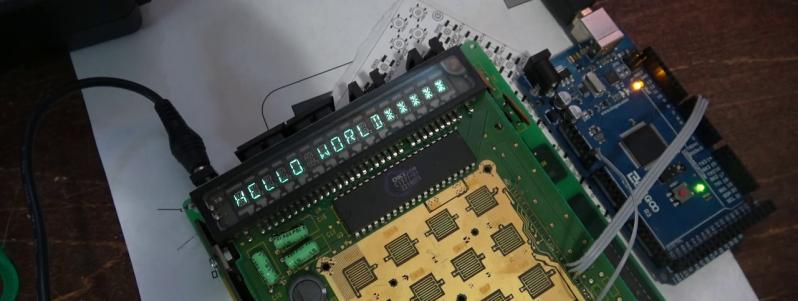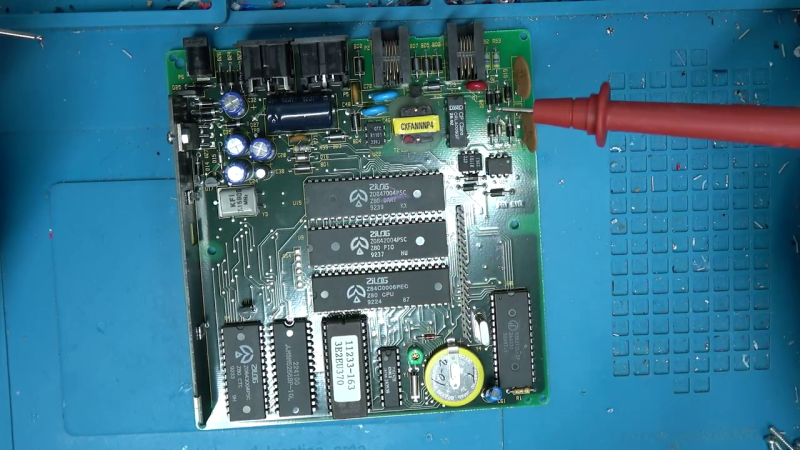[Ben Heck] found an old card-swipe point-of-sale box at the Goodwill store, took it home, and tore it down to see what was inside. He found a completely serviceable single board computer based on the Z80. In fact, there’s a whole family of four Z80 chips: the CPU itself, the DART chip (dual UART), the PIO chip (parallel input/output interface), and the CTC chip (counter/timer circuit). That’s not all — there’s a landline telephone modem, a real time clock, 32K of RAM and UV-EPROM. The second PCB of this assembly holds a hefty sixteen-key keypad and a sixteen-character vacuum fluorescent alphanumeric display. All this for the bargain price of $2.99.

Surely [Ben] will dig into the Z80 system in the future, but in this video he tries to make the display work. An OKI Semiconductor controller drives the VFD. After tracking down the data sheet, [Ben] wires it up to an Arduino and writes a quick program. Only a few YouTube minutes later, he conquers the display, drawing sample text anywhere he wants on the screen with any brightness he desires.
You never know what you may find lurking inside old equipment like this. You might find a proprietary ASIC with no documentation, or like [Ben] did here, you could find a fully functioning embedded computer. If [Ben] can whip up a RAM-based emulator to replace the 32K UV-EPROM, he’ll have a perfect evaluation board for Z80 projects.
Let us know in the comments if you have found any treasures like this. Also, how would you use this board if you had found it? Thanks to reader [Nikša Barlović] for sending in the tip.















Found? That credit card terminals use Z-80s isn’t news. CP/M was running on one at VCF Midwest seven years ago.
http://randomvariations.com/2014/09/19/cpm-running-on-a-credit-card-terminal/
It was news to me! Also Ben I think. But it’s super cool that you already knew.
Article on Tranz 330 from 10 years ago
http://www.bigmessowires.com/2011/05/06/mozarts-credit-card/
I looked for one for years but never managed to track one down.
There are quite a few on eBay US for under $20.
As for the CP/M hack, that’s a drastically different model that has a Z180 and a memory map more conducive to running that OS. The ROM on the terminal that Ben has is located at the bottom of memory and can’t be banked out for SRAM as CP/M requires.
Given that one has direct access to the bus wiring, changing the memory map is pretty straightforward.
I wouldn’t call it “pretty straightforward”. You need bank-switching, which this device most likely cannot do. The Z80 boots from $0000 (if I’m not mistaken), so the ROM needs to be mapped at $0000 at boot and then “migrate” to a higher address because CP/M needs the zero page for other stuff. The 68k has the same problem. Ironically, these two CPUs are some of the few that are suitable for CP/M.
But you do have a point. Access to the bus wiring makes every hack trivial just attach a Raspberry Pi to the bus and emulate everything you need. You can even run Linux on the card terminal.
the few? cp/m-68k is written in c. with a bit of work, it’s possible to shove it through gcc. i’ve run it on a microvax 2000 and several varieties of arm.
It was also on Hack a day: https://hackaday.com/2011/05/08/generating-music-with-credit-cards/ (from bmow’s trackbacks)
I used to snatch up credit card swipes when I found them, they almost always were full Z80 computers
The question for any electronic device with a Z-80 should be “Can it run WordStar?”
There was an old controller on a pole at work. It used to control the in floor electric heat. It hadn’t been used since before I worked there. They finally said to get rid of it last year.
It’s a Paragon EC128. Twelve relay outputs, 8 analog inputs. It has a National Semi NSC800 (Z80 derivative), 32k rom, 8k ram, nsc810 io/timer, rtc, 2×16 lcd, and 4×8 keypad.
I wish I had a good use for it.
Hey, I did this years ago. I wrote a blog about it:
http://jhallenworld.blogspot.com/2012/08/reverse-engineering-verifone-zon-jr-xl.html
This thing was made in the early 90’s, of course other people have torn it down and hacked it before. It isn’t like he is trying to proclaim that he is the first one to think of this. Difference here is, Ben is very entertaining and rides the line of entertainment and education very well IMO. This video has almost 20k views and 1.3k thumbs up in 3 days, so obviously I’m not alone in that opinion. Also, I’m sure many people seeing his video have never heard of hacking a credit card swipe, and maybe it will inspire a few of them to pick one up for a neat project. I don’t have a need for it currently, but I’m going to keep this knowledge in my toolbox should the need ever arise.
Dump the ROM contents. I found the message: “Nosey little ***, aren’t you?” when I did.
That’s fantastic. I have one (or similar) in a junk box somewhere…unless I finally pitched it. Might be time to dig it back out.
I used to work for a Point Of Sale Company in the late 80’s and 90’s in Canada where we had a relationship with Verifone and I remember this product and would say most of your video is correct. And I remember in the early days the Banks were only concerned about nefarious organizations who had money to mettle with this stuff. Then I remember the transition over time as the Banks shifted their fear to the basement hacker and that is when physical security became a primary concern for them. People hacked pinpads by putting a calculator watches inside and wiring to the pinpad keyboard so that every keypress was also entered on the display of the watch calculator hidden inside. After a Customer transaction the cashier (who was in on it) would open the back, write down the number on the calculator watch display (which was the customers pin) then press clear for the next customer. According to one story from the Banks they got caught because they hooked up the calculator watch keyboard to the pinpad keyboard wrong so they had a translation table. Problem was, their table had an error which led to their arrest. Clearly the Banks kept these stories quiet at the time.
If you decide to sell the board with the display pls give me a txt…
Brings back memories from long ago.
Back then I almost bought a bunch of network adapters for HP printers.
They had an 68000, RAM, Eprom, a bunch of IO, RJ45 with magnetics and a bunch of supporting chips.
Making that stuff do something useful was a bit over my head back then so I did not buy them.
I had a lot of fun with the old Verifone terminals. The older ones didn’t quite have all the hardware to run CP/M but they do run my monitor along with Microsoft basic. I love Z80 assembly! Many thanks to Steve Chamberlin for mapping out all the hardware addresses and disassembling the original ROM. See https://www.bigmessowires.com/2011/05/10/mapping-the-tranz-330/